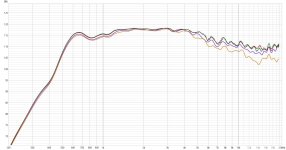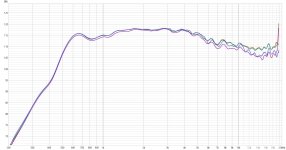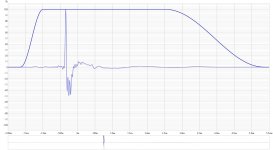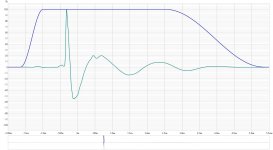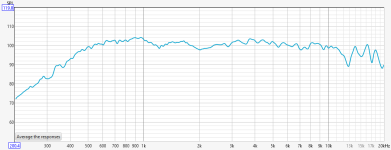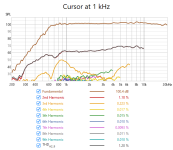Did the wavelet - looks OK I think?If anything, it's fun to hear these different pops and clicks.
//
All of this work is fascinating, and I really appreciate the level of thought and design that you all are dedicating to this.
I'm going to ask what I think is probably a rather stupid question, because sound is so subjective - but for those of you who have been experimenting with this with multiple different compression drivers, are there drivers that stand out to you in terms of how they sound vs. their technical performance? I.e., do you have a favorite driver for listening to music, performance and data aside? I realize the only way to objective compare the multitude of variables here is through data, but I'm interested in your subjective impressions.
I'm going to ask what I think is probably a rather stupid question, because sound is so subjective - but for those of you who have been experimenting with this with multiple different compression drivers, are there drivers that stand out to you in terms of how they sound vs. their technical performance? I.e., do you have a favorite driver for listening to music, performance and data aside? I realize the only way to objective compare the multitude of variables here is through data, but I'm interested in your subjective impressions.
I have recently printed and assembled two ATH520G2 horns with the BMS 4554 drivers coupled to the T520-4554-EXT.
Below are frequency responses for each, along with an impulse response and a step response. The step size off-axis is not calibrated or measured. There is no smoothing or FDW.
I also let REW generate EQ for them. A FR of the equalized response for a LR4 at 600Hz is also attached. 4 bi-quads and a shelf filter.
Below are frequency responses for each, along with an impulse response and a step response. The step size off-axis is not calibrated or measured. There is no smoothing or FDW.
I also let REW generate EQ for them. A FR of the equalized response for a LR4 at 600Hz is also attached. 4 bi-quads and a shelf filter.
Attachments
raw measurement eminence nsd2005-16 with prototype metamaterial back. a520g2 extended throat. i bought the pair for $90 shipped, i guess that's cone breakup on the top end? idk i just did a crude measurement holding the mic and horn in the air by hand. i think it can only get better. maybe ill apply some aquaplas to the diaphragm.
Attachments
Am i wrong to assume thats the best extension out of a 1" driver? -6db @ 400hz seems pretty good. Aquaplas would only lower it and mitigate some resonance.
That's a very nice extension indeed, the response below 1k is textbook. Above 11k it's all breakup of the driver. The lower usable limit is set mostly by excursion and the associated distortion. Overall this seems to be quite usable combination. It resembles a bigger driver, probably it's only not as sensitive.
Last edited:
This older driver is likely not fem optimized. Also its a 2" diaphragm to a 1" throat so theres a sharp transition there. I will continue to work with it and see how i can improve it.
I'm always plugging these, but a Dell T5810 can be kitted out with 64GB of ECC ram and a 14 core Xeon E5-2697 V3 for about $350-ish for the entire rig.
For another $80 or so, you can step it up to a Dell T7810 with twice as much ECC ram and dual sockets, for 28 cores total.
I've tried running ABEC on AWS, and running it locally is much nicer. It really seems to like a LOT of cores and a LOT of ram. I have some 8 core and 6 core Intel I7s and I9s here, and my nearly ten year old T5810s outperform them on ABEC.
Surprisingly quiet too! I have one in my living room tucked behind a couch and you can't even hear it at all.
There are newer options from AMD and Intel, but the resale market of AMD is fairly high, and Xeons have barely been improving during the last ten years. (This is why Intel stock price has gone up 20% since 2014 while Apple is up 700%.) So even a 10 year old Xeon is surprisingly capable, and they're so cheap you can buy one for little more than the cost of lunch. I think I paid $15.
I've been running T5810s almost exclusively, and have been doing a lot of nonsense with AI, you can see my stuff on Facebook
Something I learned today, that may help out:
1) Right now, you can get a 14 core Xeon E5-2697 V3 for less than $20. 14 cores, they work on a Dell T5810, the empty desktops sell for about $200 or less. That's with a power supply, case, motherboard, etc. Basically, you can get a nine year old T5810 chassis (with no CPU/GPU/Disk/RAM/etc) for about 25% as what you'd pay for a new Intel equivalent. The T5810s come with a nice power supply, but they'll happily accept a T7180 power supply, which will let you have fun with the big CPUs and GPUs. The 7810 is a dual CPU desktop, the T5810 is a single CPU desktop, same thing applies with the T7820 and the T5820.
2) Today, I ran the identical sim on one of my T5810 desktops (about $500 with no GPU) and my laptop (about $1200). Much to my shock, the T5810, despite being nine years old, absolutely BTFO'd my laptop. As we speak, the sim on my laptop seems "stuck" at 31%, and it's been running for six hours now. My T5810 finished it's sim in under four hours. The two sims were nearly identical. I just checked again on my laptop - it's been grinding away with a $200 CPU (Intel I7-12700) for seven hours now, it's at 35%, my T5810 with a $20 CPU appears to be 300% faster.
So the T5810 is obviously WAY FASTER but why is that?
I think it comes down to RAM.
My T5810 has eight DIMM slots, and the RAM is so cheap, it's nearly free. You can get 128GB for under $100.
My laptop has 24GB of RAM. 128GB for my laptop would cost about $300.
So the T5810 is nine years old, but due to the law of diminishing returns, it's probably about 60-80% as fast as a modern laptop. It's hard for me to say how ti compares to a modern desktop, as I mostly just buy old equipment for my lab, and new laptops for myself (because a nine year old laptop is typically beat to Hell, while a nine year old workstation is typically sitting under some desk at Boeing the entire time.)
Perhaps they need to be identical in order for a fair comparison - these sims seem to get stuck for whatever reason...
//
//
I've printed, sanded, assembled and tested the 5530ND and here are the spectacular results (as expected 😀):

No smoothing, 6 ms window. With no windowing and 1/6th octave smoothing:

Distortion on axis with 2nd order BW HP at 600 Hz and EQd flat:

Impulse response on axis looks like this:

Probably the best device I've measured. Great work Marcel and everyone else involved!
No smoothing, 6 ms window. With no windowing and 1/6th octave smoothing:
Distortion on axis with 2nd order BW HP at 600 Hz and EQd flat:
Impulse response on axis looks like this:
Probably the best device I've measured. Great work Marcel and everyone else involved!
Is it just me or is the HD2 mis-coloured?Distortion on axis with 2nd order BW HP at 600 Hz and EQd flat:
View attachment 1407746
Edit: Never mind, it’s just that the THD covers HD2 for almost the entire curve. The HD3 is really starting to rise at the low end but the -50 dB down is likely not audible. Fantastic.
Edit 2: any possibility you could try an LR4 filter and re-measure?
As kodomo says, cursor was at 200 Hz. Here is with cursor at 1 kHz:Distortion figures seems "odd".... what happened there? Are you playing 139dB?
//
I would say that the HD3 curve has a bit of a bump around 860 Hz, but is other than that very low. It peaks at 0.3 % at 860 Hz with a 100 dB fundamental, low enough for me.Is it just me or is the HD2 mis-coloured?
Edit: Never mind, it’s just that the THD covers HD2 for almost the entire curve. The HD3 is really starting to rise at the low end but the -50 dB down is likely not audible. Fantastic.
Edit 2: any possibility you could try an LR4 filter and re-measure?
LR4 electrically or acoustically? BW2 electrically already gives a slope around 6th order. Not sure why the raw system is 4th order acoustically.
Finnito123: Yep! Calibrated mic.
Attachments
- Home
- Loudspeakers
- Multi-Way
- Acoustic Horn Design – The Easy Way (Ath4)
